Apple Announces iPhone 7 & iPhone 7 Plus: A10 Fusion SoC, New Camera, Wide Color Gamut, Preorders Start Sept. 9th
by Ryan Smith on September 7, 2016 6:45 PM EST- Posted in
- Smartphones
- Apple
- Mobile
- iPhone
- iPhone 7
- iPhone 7 Plus
- Apple A10

Today at Apple’s annual iPhone event held in San Francisco’s Bill Graham Civic Auditorium, the company announced their next generation of iPhones: the iPhone 7 and the iPhone 7 Plus. As you might expect from Apple’s history, the two phones incorporate a number of new features and feature upgrades compared to their immediate predecessors. This includes a new SoC – the A10 Fusion – new camera options, IP67 water resistance, and top-to-bottom support for both wide color gamut (DCI-P3) displays and photography.
| Apple iPhone 7 and 7 Plus | ||||
| Apple iPhone 7 | Apple iPhone 7 Plus | Apple iPhone 6s | Apple iPhone 6s Plus | |
| SoC | Apple A10 Fusion 2 x "Fast Core" 2x "Efficient Core " |
Apple A9 2 x 1.85GHz Apple Twister |
||
| GPU | "6 Core GPU" | PowerVR GT7600 | ||
| Display | 4.7-inch 1334 x 750 IPS LCD, DCI-P3 | 5.5-inch 1920 x 1080 IPS LCD, DCI-P3 | 4.7-inch 1334 x 750 IPS LCD, sRGB | 5.5-inch 1920 x 1080 IPS LCD, sRGB |
| Size / Mass | 138.3 x 67.1 x 7.1 mm, 138 grams | 158.2 x 77.9 x 7.3 mm, 188 grams | 138.3 x 67.1 x 7.1 mm, 143 grams | 158.2 x 77.9 x 7.3mm, 192 grams |
| Rear Cameras | 12MP ƒ/1.8 OIS, Wide Color Gamut, Quad LED True Tone Flash |
12MP ƒ/1.8 wide angle, OIS, Wide Color Gamut, Quad LED True Tone Flash 12MP ƒ/2.8 telephoto, 2x optical zoom, OIS, Wide Color Gamut, Quad LED True Tone Flash |
12MP with 1.22µm pixels + True Tone Flash | 12MP with 1.22µm pixels + True Tone Flash + OIS |
| Front Camera | 7MP ƒ/2.2, Wide Color Gamut, Retina Flash | 7MP ƒ/2.2, Wide Color Gamut, Retina Flash | 5MP F/2.2 + Retina Flash |
5MP F/2.2 + Retina Flash |
| Storage | 32GB/128GB/256GB | 16GB/64GB/128GB (Launch) 32GB/128GB (Refresh) |
||
| I/O | Apple Lightning connector | Apple Lightning connector, 3.5mm headset | ||
| WiFi | 2.4/5GHz 2x2 802.11a/b/g/n/ac, BT 4.2, NFC | 2.4/5GHz 2x2 802.11a/b/g/n/ac, BT 4.2, NFC | ||
| Launch Price | $649/749/849 32/128/256GB | $769/869/969 32/128/256GB | $649/749/849 16/64/128GB | $749/849/949 16GB/64/128GB |
Jumping right into the heart of matters, in previous years Apple has alternated their upgrades between the overall design of the phone and focusing on the internal processors, resulting in the usual iPhone (X) and iPhone (X)s cadence we’ve seen over the past several years. For the iPhone 7, Apple has kept with this general development process, however relative to the iPhone 6 and 6s generations, the iPhone 7 isn’t quite as significantly a departure as past designs.
Design & Features
The overall body of the iPhone 7 series is rather similar to the iPhone 6 series. Both the regular and the Plus phones have virtually the same dimensions as their 6s predecessors, so the size of the phones is unchanged. Button placement also hasn’t changed, with volume and power buttons on the left and right sides of the phones respectively. The curved design of the iPhone series has also been retained.
So what is new for the iPhone design? In short, water resistance and a lot of polish. Apple has finally added more complete water resistance into the iPhone design for the iPhone 7 series, and the latest phones are IP67 rated for water resistance. Like we’ve seen with other IP67 phones, it should be noted that water “resistance” is the key word there; this level of protection is designed to resist water damage to the phone in the case of accidents, and it’s not meant for long-term submersion (swimming and the like).
Meanwhile on the polish side, for this generation Apple has further refined the overall design of the iPhone. Apple has taken a particular interest in going “seamless” this generation, further reducing the presence of seems in the phone where the glass meets the case and along the antenna bands. Apple has also introduced some new color options here: a matte black finish (seemingly replacing Space Grey), and a glossy “jet black” finish, the latter of which literally involves a polishing process. Apple is treating the jet black finish is this generation’s premium finish option, and as a result it is only available on the more expensive 128GB and 256GB phone models.
However the biggest change here is probably the home button, which is now entirely solid state. Apple has integrated their force touch technology previously used for the iPhone 6s screen and the MacBook trackpads into the home button, removing the mechanical aspects of it. Instead, like the aforementioned devices, what you’re looking at is a pressure-sensitive surface with the taptic engine being used to simulate the necessary feedback. The home button was one of the last few mechanical parts in the iPhone, and Apple is touting this as improving the reliability of the button. At the same time I wouldn’t be surprised if it was also part of the work that went into making the phone water resistant. It will also be interesting to see what Apple eventually does with the pressure sensitivity, given that they’ve tried to make it an important part of the user experience with the iPhone 6s and its force touch screen.
On the display side of matters, Apple has taken a page from this year’s 9.7” iPad Pro launch and upgraded the iPhone for DCI-P3 wide color gamut support. Apple has increasingly been going DCI-P3 capable throughout its entire product lineup, and P3 is quickly becoming by far the most commonly supported of the wide gamut standards across the industry. In the case of the iPhone 7, this is part of a larger upgrade to implement top-to-bottom wide color gamut support, with the phone’s cameras also getting a similar upgrade. The advantage of the larger color gamut, as we’ve seen with the iPad, is that it allows for representation of “deeper” colors that can’t be covered by the traditional sRGB color space, ultimately getting closer to reproducing the full spectrum of what humans can see. As pointed out by our own Brandon Chester however, these new phones don’t include the iPad’s True Tone capability, which allows the display’s white point to be changed with the color temperature of the surrounding lighting.
Along with the addition of wide color gamut support, the panels in the new iPhones are also 25% brighter according to Apple, with a typical max brightness of 625 nits (for reference, we measured the max brightness of the iPhone 6s at 567 nits, compared to an official spec of 500 nits). What hasn’t changed however is resolution; these are still Retina HD displays, meaning we’re looking at 1334x750 pixels for the 4.7” iPhone 7, and 1920x1080 pixels for the iPhone 7 Plus.
At the other end of the spectrum then are the iPhone 7 series’ new rear and front facing cameras. Starting with the iPhone 7, Apple has retained a 12MP sensor (sensor manufacturer unknown), however they have significantly improved the feature set available. The new camera module is capable of taking wide color gamut photos to go along with the WCG-capable display. Furthermore, in a rarity for a sub-5” phone, the iPhone 7 now includes optical image stabilization (OIS) for both photos and video recording, a feature that was previously only available on the larger Plus phones. The new camera is composed of a six element lens, and along with its other improvements, the sensor is said to be 60% faster and 30% more energy efficient than the previous-generation sensor in the iPhone 6s. Also augmenting the new camera is an updated true tone flash light; the new module is composed of 4 LEDs, allowing for what Apple says is 50% more illumination than the iPhone 6s.
Meanwhile for the iPhone 7 Plus, Apple has added a second 12MP camera. What sets this second camera apart from the first is the lens; complementing the normal wide-angle lens on the primary camera, the second camera uses a 56mm, f/2.8 telephoto lens, offering a tighter picture with an effective 2x optical zoom over the primary camera. Apple has been pushing the camera aspect of the iPhone for many years now, and with the latest iPhone they are branching out into one of the few things most smartphone cameras haven’t been able to address with optical zoom. Besides allowing for closer photos, the second camera will also be used to do depth measurements, allowing the iPhone 7 Plus to do depth of field effects.
Finally, both phones have also received a new front facing camera. This new camera is 7MP, and like its rear facing counterparts supports wide color gamut photos.
As for audio capabilities, Apple has taken both a step forward and a step back. Moving forward, the headset speaker towards the top of the phone has been upgraded to be a full-fledged, full volume speaker. As a result, the iPhone can now play back stereo sound when in landscape mode by combining this with existing speaker at the bottom of the phone. Apple says the new speaker system is 2x louder – though it’s not clear if this is just adding up the output of the two speakers – and we’re told that the iPhone 7’s speakers support a greater dynamic range.
However taking a step back, as rumors have previously indicated, Apple has removed the 3.5mm audio jack on the phone. For external audio, Apple is now telling users and accessory manufacturers alike to use the Lightning port. Of note, this necessitates putting a Digital to Analog Converter (DAC) in headphones and other devices that directly connect via Lightning, which is going to have interesting ramifications on audio quality differences between products and how they are priced. Otherwise for existing 3.5mm devices, Apple is also including a Lighting to 3.5mm audio adapter, which of course also integrates the necessary DAC.
Given that they’re removed the audio jack, Apple has upgraded their EarPod earbuds for the new iPhone. The new models are lightning based, though otherwise apparently unchanged from their predecessors. A bit farther down the line, Apple will be releasing a wireless earbud product, the AirPods, with which they intend to do away with concerns about wired connections entirely by going wireless.
A10 Fusion: The Next Apple SoC
Finally, last but certainly not least is the heart of the iPhone 7 and 7 Plus: the SoC. While Apple has traditionally focused on bigger improvements in the off-year s-generation updates, they have made something of an exception for the iPhone 7 with the A10 Fusion SoC.
The major change here is that with the A10, Apple has embraced the concept of multiple types of CPUs, each with different power/performance characteristics. This is something that has been prevalent in SoCs based around ARM Cortex-A CPU designs used in most Android phones, but Apple had (until now) opted to stay with a single cluster of two CPU cores.
There’s a lot of information to chew here, and a product announcement isn’t nearly enough to cover everything, but the basic theory behind a multi-type/multi-cluster design is to further min/max power efficiency by developing a set of high performance, high power cores for tasks that need maximum performance, and a second set of low performance, low power cores for simpler tasks that need only a small amount of computational time. By not sending the latter tasks to the high power cores, in theory you save on power consumption. This is the basis behind ARM’s big.LITTLE design philosophy.
The trade-off with this philosophy is that you now have to manage migrating tasks between the CPU clusters, which itself has a power cost. So while it’s a more efficient route in theory, in practice it can be difficult to implement, especially in a performant manner. Apple has previously stuck with their single cluster design, using the same CPU cores to run the gamut from low power to high performance, and while we may never get a full answer, I am very curious what happened behind the scenes at Apple and what they found to get to this point.
In any case, the A10 implements two types of cores; a pair of high performance cores, and a pair of low power cores. The slower cores are said to consume one-fifth the power of the high performance cores, though Apple has not indicated what performance is like. As is traditional for Apple, they haven’t said anything about the CPU cores themselves, but it’s a safe bet that the high performance cores are a direct descendant of the Twister cores used in the A9. More curious will be what the low-power cores are – given Apple’s fondness for developing their own ARM CPU cores and various technical considerations (such as the core interfaces), it may very well be that these are also Apple-designed cores, as opposed to an off-the-shelf solution like ARM’s Cortex-A53.
One thing Apple has emphasized in talking about the A10 is that their design uses a custom designed performance controller to manage the CPU cores and migrate tasks between them. This revelation of a hardware controller does imply that Apple is using some form of cluster or CPU migration – that is, only ever using 2 cores at once and not using all 4 cores at the same time in a heterogeneous manner – but all of this is speculation and subject to confirmation. Either way, this is the biggest change to the structure of Apple’s CPU subsystem since A7 and the Cyclone CPU core in 2013, and given Apple's habit of throwing us curveballs on the SoC side, I suspect the answer is not as simple as what we currently believe.
Meanwhile on the GPU side, Apple has uncharacteristically confirmed that A10 implements a “6 cluster” GPU design. This removes a good bit of guessing work here, as the significant scalability of GPUs has always made it difficult to pin down the number of GPU clusters. A good bet here is that Apple is using another PowerVR design – either a higher clocked version of the PowerVR GT7600 used in the A9, or perhaps a six cluster design based on the more recent PowerVR Series7XT Plus architecture – but that’s something that remains to be seen.
From a performance standpoint Apple is once again touting significant performance gains versus the A9 and previous SoCs. CPU performance (of the high power cores) is said to be 40% better than the A9 and its dual 1.85GHz Twister CPU cores. Meanwhile GPU performance is said to be 50% higher than A9’s PowerVR GT7600 GPU. Obviously we’ll have to see how well performance holds up in our benchmarks, but if Apple can actually deliver on these claims then this would be a significant gain for a non-s generation product, and one made all the more impressive as Apple will not have received the advantages of a die shrink with this generation.
Finally, no information about the RAM paired with the A10 is available at this time. However we’re very happy to see that the traditionally conservative Apple has finally given the iPhone line a bump in NAND capacity. The entry-level model is now 32GB, and the higher capacity tiers have been bumped to 128GB and 256GB respectively.
Final Words
As for battery life, Apple has not released any hard details on the capacity of the batteries being used in the iPhone 7 and the 7 Plus. However they are claiming yet another increase in average battery life. Overall Apple says the average increase for the iPhone 7 over the 6s is 2 hours, and a smaller 1 hour increase for the iPhone 7 Plus over the iPhone 6s Plus. Curiously, Apple’s official 3G talk time numbers are the same (or have regressed) compared to the iPhone 6s, at 14 hours for both the iPhone 6s and iPhone 7. Instead Apple’s metric of choice is LTE internet use, which on the same phones has increased from 10 hours to 12 hours. So at first glance, assuming Apple hasn’t regressed on modem power usage, these power gains would seem to come from improvements to the A10 SoC and possibly the display.
Wrapping things up, Apple is going to be bringing the new iPhones to market rather quickly. Pre-orders for the phones open up on the 9th, and they’ll begin shipping one week later on the 16th. Phone pricing for the iPhone 7 is unchanged from the iPhone 6s, with the base 32GB model starting at $649 and each capacity bump going up $100 from there. Meanwhile the iPhone 7 Plus is just a bit more expensive, seeing a price bump at all capacities of $20, putting the starting price at $769.


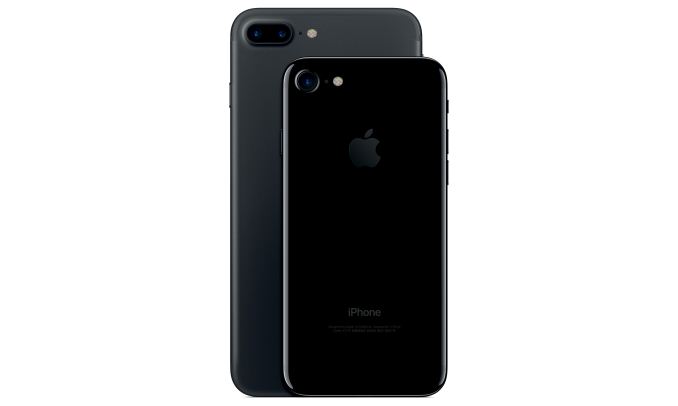
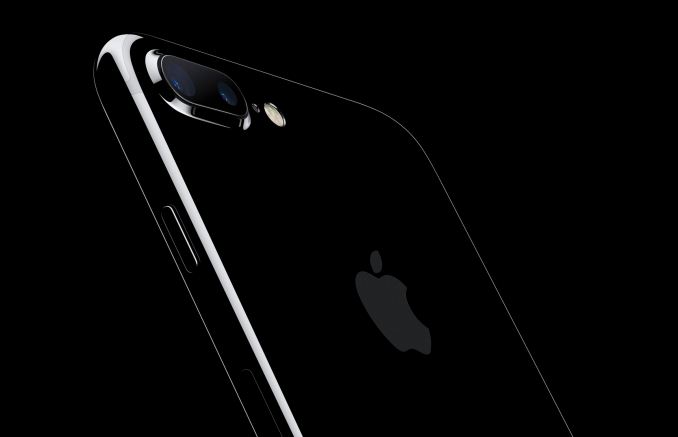
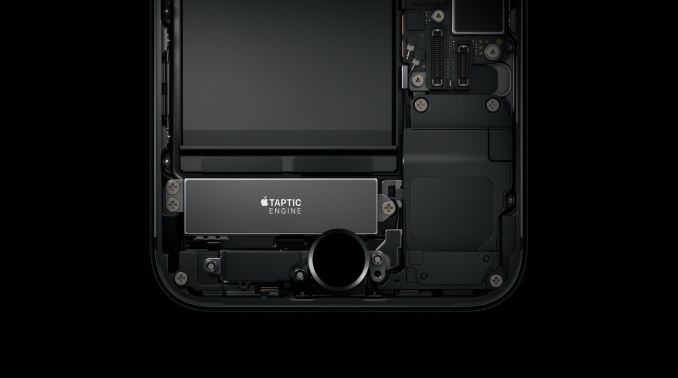

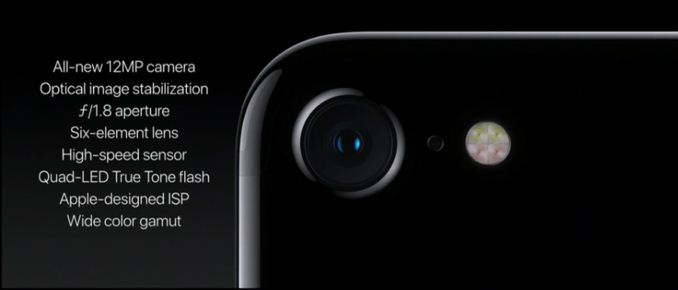

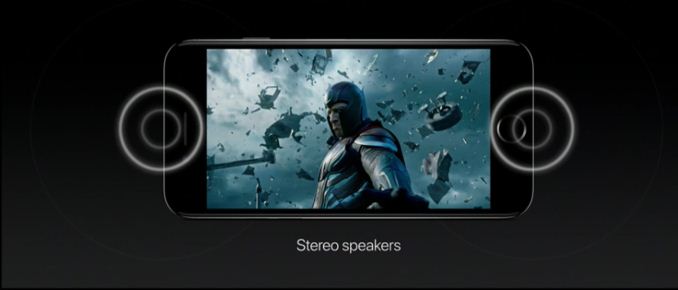
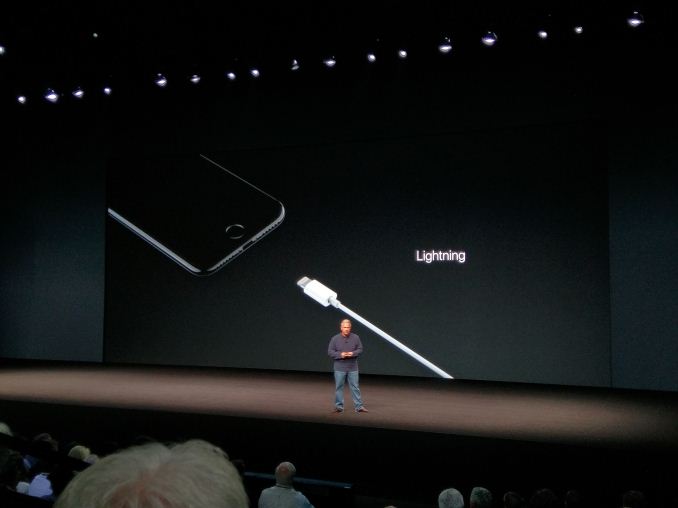

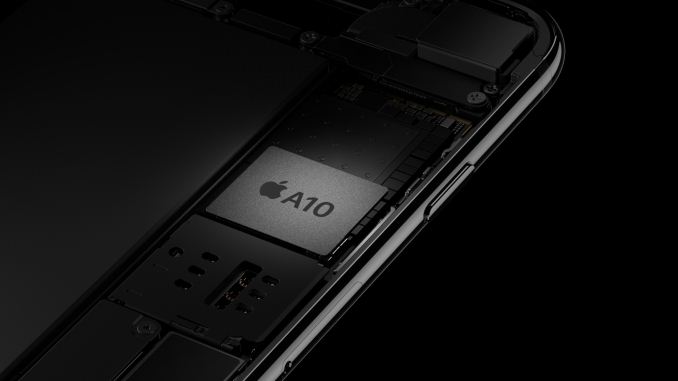
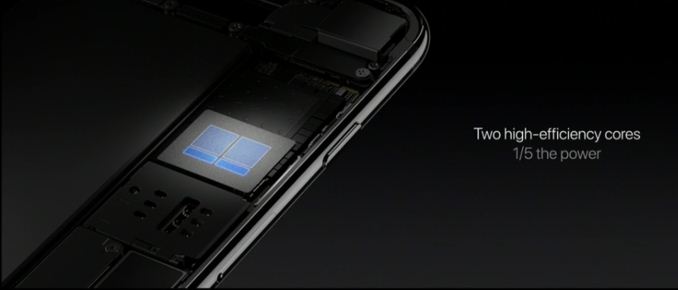
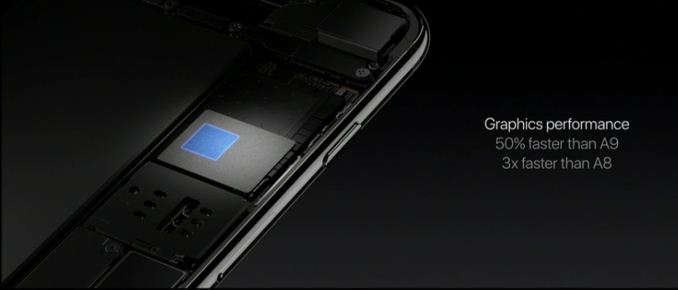

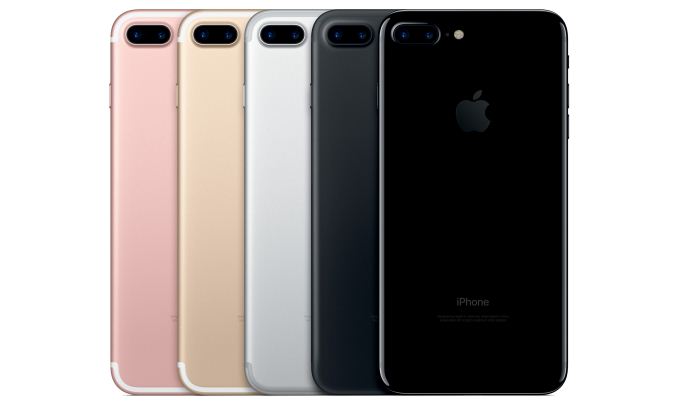








97 Comments
View All Comments
lilmoe - Saturday, September 10, 2016 - link
---"but all those are just circumstantial facts"Agreed. There isn't a single best solution for "all". Each platform has its needs and priorities. What's best for iOS is absolutely not the same for Android; part of the argument we had back in Andrei's article about task/thread scheduling.
---"The difference in power savings between the iPhone 7 and 7 Plus might be proof that a larger screen has a bigger impact on battery life than the SoC"
But the Plus model also has a significantly larger battery, and it usually gets better overall in-use battery life (screen-on time) than the smaller model. Since the larger battery makes up for the extra screen real-estate, and then some, I had initially thought the Plus would gain even more battery savings. It only makes sense since the newer processor should be more power efficient, and that's before adding the little cores to the equation. It's unlikely that the new screen isn't as efficient as the old one at least (should be more so).
This might be a direct result of the extra screen resolution, where the little cores (or the improved efficiency of the processor, not sure about Apple's implementation) are enought to offset 720p (or the larger cores are more efficient at lower clocks), but not very much so for 1080p.
Another possibility is the fact that iOS 10 has increased framerates and overall responsiveness. Not so sure, but this might *not* be a direct result of more efficient software, but a more aggressive governor/shell where the SoC is being pushed harder for common tasks. As a result, iPhone 6/6S users might actually get lower in-use battery life compared to previous iOS versions on average. Again, who knows.
---"I can't see why a wide dual-core CPU can't be the better approach for fanless designs, despite your comments about modern apps and workloads. Intel seem to be getting along just fine"
I'm no "expert" either. But Laptops (regardless of CPU cooling), or ultrabooks, are a completely different ballgame, let alone PCs with constant power supply and a larger fan. Absolutely not comparable. Apple and Intel's dual core solutions are adequate for their intended workloads, but that's not the issue. It's an issue of *how long* can you afford pushing these CPU at an average/high power draw before racing to sleep. Efficiency can vary dramatically on the type of workload and how the platform is implemented. Intel's first 5 watt Core-M iterations proved LESS efficient than their 15 watt counterparts because of this very reason.
I'm sure the difference is apparent to you now. What's acceptable for a laptop's relatively large battery, and thermal headroom, is absolutely NOT the case for a relatively tiny smartphone. Don't underestimate the power draw of these processors (especially Apple's), they can completely shadow the max power draw of the screen if pushed hard enough. It's shame Anandtech refuses to make direct power draw comparisons between Ax SoCs and the competition.
You probably know this, and I don't want to be redundant, but we've reach a point of perfectly acceptable single core performance (Twister, Kryo, M1, A73). The spec race needs to slow down here and move to the next step; effeciency. More processing cores aren't just about performance, they can play a major efficiency role, even for wide cores, when racing to sleep isn't fast enough. Even for the same architecture, 4 cores at 800MHz would yield more sustainable performance and much more efficiency than 2 running at 1.6GHz. This goes a long way when you have 2 clusters, each with multiple cores, and each for specific dedicated tasks OR for global task scheduling. It would be interesting to see how well Intel's upcoming quad-core Core-M processors fair against their dual-core counterparts in future products in terms of battery life.
yhselp - Saturday, September 10, 2016 - link
The way I'm thinking is the Plus has a bigger screen, but it also has a bigger chassis, which can house a larger battery, which in turn is enough to offset the impact of the big screen and even add additional battery life compared to the standard model. However, all that doesn't mean that the screen still can't have a bigger impact on battery life than the SoC. Therefore, an SoC-related power improvement could be more beneficial for the standard model, despite the smaller battery. I could be totally wrong, of course. As you've said - there's no way to know for sure now. The power draw of Apple's SoCs might very well be higher. It'd be nice to get more statistics from Anandtech; but, again, what we can see is that the performance and battery life of an iPhone are both there, despite what the power draw might be.I do understand that different platforms and form factors have different needs, but judging by your arguments I might be underestimating just how different those might actually be. I simply don't know enough. Still, how can a tablet (not a laptop or desktop) like the Surface Pro 4 powered by a wide dual-core Core M running a full-fledged desktop OS have great performance and battery life if the ballgame is completely different? It'd be very interesting indeed to see a quad-core ~4.5 W Core CPU from Intel.
You're not being redundant, on the contrary. The way I understand what you're saying is, and correct me if I'm wrong, that we've reached a point where a single core of a mobile CPU is fast enough for its intended purpose, and so from now on we should favor more cores per cluster as a means to improve efficiency, because that has become the more important thing to try and improve. Which essentially means that the iPhone 6s and other similar products represent the best performance we can expect of smartphones for a long while. If that is the case, it'd be very unfortunate from my point of view. I'm the kind of user that feels you can never have too much performance, that no solution if ever "good enough". More battery life is nice, but I would always choose more performance with the battery life we have today if given a choice. I feel that only a historic scientific breakthrough that produces a new power source can dramatically improve battery life of electronics without increasing their weight and size.
I'd like to think that I'm aware that this greed for performance might not be the best thing overall, but I still want it, and if it weren't for it I wouldn't invest in a flagship smartphone - that's not to say performance is the only thing I favor in a device, far from it, and I definitely haven't and won't upgrade every year. At the end of the day, I think that a 6700K at 4.6 GHz with 3200 MHz memory and a 480 GB SanDisk Extreme Pro is definitely not fast enough. It is not disappointing, it does meet expectation, but it can definitely be faster, and I'm very much looking forward to what Intel (and AMD, hopefully) comes out after 2 and after 5 years respectively, judging by their current roadmap.
Wonderful discussion we're having.
lilmoe - Saturday, September 10, 2016 - link
---"Therefore, an SoC-related power improvement could be more beneficial for the standard model, despite the smaller battery. I could be totally wrong"I read your take on it and was like, DUH. I was just explaining how CPU efficiency isn't as crucial in laptops with larger batteries.... You're totally right, completely my oversight.
---"Still, how can a tablet (not a laptop or desktop) like the Surface Pro 4 powered by a wide dual-core Core M running a full-fledged desktop OS have great performance and battery life if the ballgame is completely different?"
The Surface despite being in tablet form, has laptop internals. Internals and OS are totally identical. Just like how you offset the larger screen with a larger battery, you do the same for the higher power draw of the processor during average usage. Again, for the same processor/SoC, a desktop OS would generally consume more power because the processor is working harder relatively. That being said, Windows 10 is pretty damn efficient for a desktop OS. Despite that, you can clearly see how the iPad Pro has significantly better battery life despite having a slightly smaller battery; because the iPad runs iOS, not OSX.
---"I'm the kind of user that feels you can never have too much performance"
Look at Intel. How much did their IPC improve over the past 3-4 years? Nothing close to what Apple is reporting. AMD's Zen isn't breaking any grounds by any means. I'm not saying that Apple is lying, but the alleged improved performance comes at a cost. A huge one in fact. Despite that, it's only in very short burst in practice, and the difference is virtually imperceptible provided they don't cripple their older hardware too much (sorry, but their history proves otherwise. Part of my argument: if older hardware had more cores, the burden would have been much easier to remedy).
I'm not trying to be hateful or offensive, but this is absolutely NOT in the best interest of the Apple consumer, and consequently the consumers of OEMs that follow suit. Finding more and more ways to increase perceived performance is rendering older hardware obsolete at shorter periods of time. Yes they're improving their OS, but they're not working hard enough to make those changes meaningful in a way that older hardware doesn't suffer.
I totally respect your desire to have the latest and greatest, but not everyone can afford (or even wants) that. They sell 10s of millions of those, and I believe consumers are better catered to with sustained performance of their older devices, NOT the "latest version of iOS", while still getting security updates of course. BUT, consumers are either forced to update to a "slower" OS, or face potential security issues............ That's one of my gripes with Apple.
I'm glad you agree though. A flagship isn't only about performance. But a flagship shouldn't only be better in performance compared to lower range devices, it should also outlast their life spans by a VERY significant margin. That's why you buy better appliances, electronics, cars, etc...
lilmoe - Saturday, September 10, 2016 - link
"I was just explaining how CPU efficiency isn't as crucial in laptops"Quoting myself, and just to make it clear that I'm not misunderstood. Efficiency is JUST as important in any form factor. It's which processor that's *more efficient* for a given workload, at an "acceptable performance level", that matters.
yhselp - Monday, September 12, 2016 - link
I completely agree with most of what you're saying, and despite my belief that performance is very important, I don't upgrade every year, not even every two years. A flagship should absolutely last very long - at least four years, and as you've said Apple have been guilty of slow performance on relatively new devices. If there's one thing I truly hate about them it's that. I still remember how apps used to run fine on my 3GS until I upgraded iOS. I still think it's ludicrous that the 5s - the most evolutionary iPhone in terms of performance - drops frames, many apps work slower, is slower overall, and the UI isn't well-optimized for its 4" screen on iOS 9 which was released just two years after its launch. I really hope iOS 10 fixes those issues.And if the solution to those problems is the addition of more cores per cluster at the expense of the most up-to-date flagship not being the absolutely fastest it could be for the short period of one to two years, then so be it. I haven't really thought about it this way before.
Of course, the sad thing is that Apple might not be interested in providing stellar performance for their iPhones for too long.
On the Surface Pro subject - I'm not so sure about what you're saying. The Surface Pro 4 has the same battery capacity as the iPad Pro, weighs just a few per cent more, and its battery life is not dramatically lower - less than 30% difference, I think. In this case, I consider Microsoft's tablet the superior product in almost every way - it's faster, more practical, and still sexy. Doesn't matter how it's built; the end-result matters. I'd be more than happy to sacrifice about 30% of battery life for all the rest when I still get many hours of use.
For for taking so long to reply - I've been busier than usual.
yhselp - Monday, September 12, 2016 - link
*Sorry for taking so long to reply - I've been busier than usual.lilmoe - Tuesday, September 13, 2016 - link
It's OK. I have a busy life as well, and mostly participate from my phone when I'm out (unless it's a long reply).I have no doubt that modern Windows 10 tablets are the superior form of a tablet computer, and the Surface being the best one of those. Even for mobile operating systems, I believe Windows 10 Mobile is the absolute best of both worlds; it's like (or better than) iOS in terms of sandboxing and efficiency, AND it's pretty close to the flexibility and power of Android. It's just too bad, and heart breaking, that Microsoft failed miserably in delivering, despite the amazing job their engineers are doing with their Universal Windows Platform. Windows 10 Mobile also benefits from indefinite updates delivered directly from Microsoft (unless the update was in firmware). I always dreamed of an Exynos powered Galaxy S running Windows 10........ Oh well.
Back to the topic of battery, I was specifically debating battery life in comparison with a mobile OS. Had the same Surface Pro been equipped Windows 10 Mobile, for example, it would have definitely yielded better battery life, albeit being less practical. Rundown tests rarely paint a true picture of the actual battery life in practice, if ever. You see phones lasting just as much as others, give or take, but in practice one could have double the battery life of the other...
yhselp - Wednesday, September 14, 2016 - link
It's a shame about Microsoft, yes. I remember being hyped about the original Window Phone 7 being the best of both worlds back in 2010. I also remember one guy I know actually being worried about potentially having to swap his shiny iPhone 4 for a superior device so soon after release. I've lost count the people I've tried to convince Windows Phone is a great OS. A real shame Microsoft hasn't developed it properly.NetMage - Wednesday, October 5, 2016 - link
Don't forget the Plus also has 50% more RAM, which is expensive to power.michael2k - Wednesday, September 7, 2016 - link
From their materials, I expect their A10 to be a pair of Twisters clocked to 2.6GHz (literally 40% faster) and paired with two A7's Cyclone cores. Shrinking the Cyclone from 28nm to 16nm gives us two die shrinks, and running at half the clock (1.3GHz was the Cyclone's native clock) means they can literally run at 1/5th the power usage while still be at full throttle.